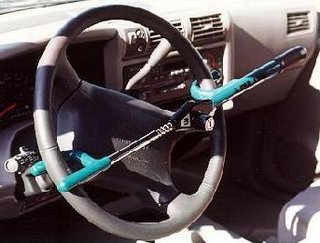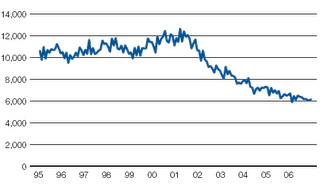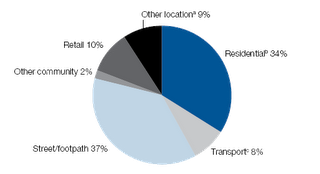|
 The Baltimore County Police Department has been participating along with Baltimore City Police and the State's Attorney's Office in a grant funded project entitled the Regional Auto Theft Task Force. Part of the mission of the group was to do research on the problem of auto theft, in addition to investigating auto thefts and enhancing arrests, thereby reducing the number of incidents regionally. Specifically three questions surfaced as needing answers from the research: - Does the use of an anti-theft device make a vehicle less susceptible to being stolen?
- Is a thief deterred from stealing a car that uses an anti-theft device?
- Is any specific device more effective than the other?
Findings: During the period of study, from June 1 to October 31, 1995 there were 2,411 vehicles reported stolen to the Baltimore County Police Department. Of that number, 930 vehicles were recovered within the same time frame. The results of this study are based upon the physical examination of 739 (79%) of the stolen vehicles that were recovered. The findings are as follows: Anti-Theft Devices are a deterrent to thieves. The survey showed that 95% (701) of the recovered stolen vehicles either did not have an anti-theft device, or did not use it. Only 5% (38) of the recovered vehicles were found to have used an anti-theft device which was defeated. "Kill switches" may be effective and would prevent many vehicle thefts.
72.4% (535) of the vehicles had their ignition defeated, either by pulling out the ignition switch or by breaking the steering column. ( A kill switch is most often a toggle switch hidden in the car which the operator flips when exiting. The switch deactivates the ignition system. Some alarms automatically deactivate the ignition when they are set off.)
Too many owners leave keys in vehicles/engine running.
25% (181) vehicles had keys in the ignition.
Most vehicles were locked.
Physical force was used to defeat 62% of the vehicles in the study. However 38% of the recovered vehicles were unlocked at the time of theft.
Conclusion:
Too few car owners use anti-theft devices.
The "CLUB" was the most prevalent anti-theft device present. It was also the least often used device (ie: In car not attached). Three important points to note about the club are: - It's low cost makes it affordable.
- It is one of the few anti-theft devices that is visible to thieves. (Deterrent)
- A device, no matter how sophisticated, cannot be effective if it is not used.
It is concluded that the project's goal of determining the effectiveness of various anti-theft devices can only be achieved after the public uses these devices more often. Therefore, Lock your car Take the keys with you Use an anti-theft device.
              
posted by transport blogs
@ 12:56 AM
permanent link | |
0
comments

While there is no foolproof way to safeguard a vehicle against theft, there are many "no cost" deterrents owners can use to protect themselves and their automobiles. For example, a thief's greatest enemy is time. The more difficult your vehicle is to steal, the longer it takes to be stolen. The longer it takes, the more likely it is that the thief will move on to an easier target. Don't become complacent because you drive an older-model vehicle. Older vehicles can be resold quickly or stripped for parts. A vehicle's parts are worth two or three times the value of the vehicle. Here are some tips to help protect you and your vehicle: - Close all windows, lock all doors and take the keys with you. In Florida, almost 25 percent of stolen vehicles had the keys in them.
- Never hide a second set of keys anywhere on your vehicle. Thieves know all the hiding places.
- Never leave your vehicle running, even if you will only be gone for a minute; Vehicles are commonly stolen at convenience stores, gas stations and ATMs.
- Park in well-lighted areas. Over 50 percent of vehicle thefts occur at night.
- Use your garage; lock both the vehicle and the garage. Locking both doors greatly reduces the chance of theft.
- Keep your garage door opener with you. The thief may attempt to get into your house.
- Don't leave your original registration or title in your car. File the title at home in a safe place and carry your registration in your purse or wallet. When sharing a vehicle, provide a copy of the registration to other drivers to carry in their purse or wallet. If a thief has these two documents, your car will be easier to sell.
- Park in attended lots. Thieves don't like witnesses.
- Park your vehicle with wheels turned toward the curb, even when parking in driveways and parking lots. This makes your vehicle difficult to tow.
- Don't become complacent because you drive an older-model vehicle. Older cars can be resold quickly or stripped for parts. A vehicle's parts are worth two to three times the value of the car.
- Put all packages and personal items out of sight. Items left in the open make your vehicle a more desirable target.
- Have your VIN number etched onto your windows. This makes it difficult for a thief to switch VIN numbers on a stolen vehicle
              
posted by transport blogs
@ 3:55 AM
permanent link | |
0
comments

- Motor vehicle theft is the taking of a motor vehicle unlawfully or without permission. It excludes damaging and tampering or interfering with motor vehicles. The theft of motor vehicle parts or contents is included under the offence category of other theft. Motor vehicle refers to cars, motorcycles, campervans, trucks, buses and plant/equipment.
- * There were 75,115 motor vehicles reported stolen to police in 2006, with 523 vehicles stolen per 100,000 registered vehicles. This represents a 7% decrease on the number of thefts recorded in 2005. On average, there was one MVT every seven minutes in Australia in 2006.
Trend in motor vehicle theft Trend in motor vehicle theft, by month, 1995-2006 (number) Source: Extracted from Australian Bureau of Statistics recorded crime data - In February 2006, motor vehicle theft decreased to the lowest monthly level recorded since 1995 with 5,890 motor vehicles reported stolen.
- The incidence of recorded monthly motor vehicle theft peaked in March 2001, with 12,651 cars recorded stolen in that month.
- Between March 2001 and December 2006 motor vehicle theft registered a 51% decrease. The overall decrease in the period 1995-2006 was 41%.
- Friday and Saturday evenings are the most popular periods for theft.
- In the period 1995-2006, the average recorded number of vehicles stolen per month was 9,621।
Location of motor vehicle theftLocation of motor vehicle theft, by type of location, 2006 a: Includes unspecified location (n=1,218) b: Includes dwellings and other residential locations c: Transport includes public car parks Source: Australian Bureau of Statistics 1997-2007. Recorded crime, victims, Australia (various years; title varies). ABS cat. no. 4510.0. Canberra: ABS - The majority of motor vehicle thefts occurred on the street/footpath (37%) or in some sort of residential location (34%).
- Only 8% of motor vehicle thefts occurred in what are classified as transport locations, such as car parks.
For more information http://www.aic.gov.au/topics/property/stats/mv_theft.html
              
posted by transport blogs
@ 9:27 PM
permanent link | |
0
comments

Austrade-assisted DataDot Mexico is providing a low-cost innovative security solution to help Mexico City's law enforcement authorities win their battle against increasing car and motorcycle theft.
The Australian owned company has recently signed an agreement with the Police General (PJDF) of Mexico City to reduce motor vehicle theft, provide training to the Police General's auto theft investigators and work together to make the establishment of DataDots mandatory within the state.
Rohan Claringbold, DataDot Mexico's President, said its anti-theft technology involves spraying on-average 4,000 tiny DataDots throughout each car. Each DataDot contains a unique PIN that is registered on the DataDot Mexico database with the vehicle's identification number (VIN), allowing authorities to check for stolen or 'rebirthed' cars and track down stolen parts.
"Mexico has a high auto theft rate with stolen cars being 'rebirthed' for entry in the USA, Canada, Central and South America. The DataDot database will be accessible by auto theft investigators in Mexico and all of those countries," Mr Claringbold said.
"This is a major step forward in providing the Mexican public with an affordable and effective solution to protecting their vehicles from theft and DataDots acceptance as an economical tool in this fight has been overwhelming, particularly with insurance companies, manufacturers and the general public. We are expecting strong revenues.
"Already we are seeing insurance companies provide discounts if DataDots are used and combining this with our $20,000 peso warranty vehicle owners are receiving a great financial benefit," Mr Claringbold said.
"We are also in discussions with insurance companies to offer the DataDot Spray System to their Insurance and Auto Dealership clientele," he said.
"Austrade has been very helpful and part of the success in regards to getting us where we are today.
"They have helped us with arranging and attending appointments with the state and federal governments in Mexico, allowing us to officially release the product to the insurance industry at the Australian Embassy in Mexico City and more," Mr Claringbold said.
Garry Kennedy, Austrade's Mexico City-based Trade Commissioner, said Mexico is one of the world's most important developing countries and a key economy in Latin America.
"Their innovative product has found a niche market and has been well received by insurance companies, auto manufacturers and the population as they are motivated to fight this situation," Mr Kennedy said.
"Austrade works closely with many Australian companies in a range of sectors to help enhance new market opportunities in Mexico. Promotional events are conducted regularly to boost sales of Australian food and wine, education, tourism and mining technology and services," he said.
"The relationship has grown as Australian companies in a range of industries (mining services and technology, agribusiness, food and beverages, IT, software, biotechnology, automotive parts and education and professional services) enjoy success in Mexico.
"This is aided by the double taxation agreement, a bilateral investment protection agreement and memorandums of understanding on agriculture, education, energy, ICT, and mining which are helping to bring both economies together," Mr Kennedy said.
Tim Harcourt, Austrade's Chief Economist, said Mexico is an emerging market for Australian exporters in the American hemisphere.
"Around 374 Australian businesses export to Mexico, which makes it the second most important exporter destination in Latin America after Brazil," Mr Harcourt said.
"Australia's exports of goods and services to Mexico totalled $880 million for the 2007 financial year and increase from approximately $846 million the previous year," he said.
              
posted by transport blogs
@ 11:17 PM
permanent link | |
0
comments

1874.2. (a) Upon written request to an insurer by an authorized governmental agency, an insurer or agent authorized by that insurer to act on behalf of the insurer, shall release to the requesting authorized governmental agency any or all relevant information deemed important to the authorized governmental agency that the insurer may possess relating to any specific or motor vehicle insurance fraud. Relevant information may include, but is not limited to, all of the following:
(1) Insurance policy information relevant to the motor vehicle theft or motor vehicle insurance fraud under investigation, including, but not limited to, any application for a policy.
(2) Policy premium payment records that are available.
(3) History of previous claims made by the insured.
(4) Information relating to the investigation of the motor vehicle theft or motor vehicle insurance fraud, including statements of any person, proof of loss, and notice of loss.
(b) (1) When an insurer knows or reasonably believes it knows the identity of a person whom it has reason to believe committed a criminal or fraudulent act relating to a motor vehicle theft or motor vehicle insurance claim or has knowledge of the criminal or fraudulent act that is reasonably believed not to have been reported to an authorized governmental agency, then, for the purpose of notification and investigation, the insurer, or an agent authorized by an insurer to act on its behalf, shall notify the local police department, sheriff's office, the Department of the California Highway Patrol, or district attorney's office, and may notify any other authorized governmental agency of that knowledge or reasonable belief and provide any additional information in accordance with subdivision (a).
(2) When an insurer provides the local police department, sheriff's office, Department of the California Highway Patrol, or district attorney's office with notice pursuant to this section, it shall be deemed sufficient notice to all authorized governmental agencies for the purpose of this chapter. Nothing in this section shall relieve an insurer of its obligations under Section 1872.4.
(3) Nothing in this subdivision shall abrogate or impair the rights or powers created under subdivision (a).
(c) The authorized governmental agency provided with information pursuant to subdivision (a) or (b) may release or provide that information to any other authorized governmental agency.
(d) An authorized governmental agency shall notify the affected insurer in writing when it has reason to believe that a fraudulent act relating to a motor vehicle theft or motor vehicle insurance claim has been committed. The agency shall provide this notice within a reasonable time, not to exceed 30 days. The agency may also release more specific information pursuant to this section when it determines that an ongoing investigation would not be jeopardized. The agency may require a fee from the insurer equal to the cost of providing the notice or the information specified in this section.
(e) An insurer providing information to an authorized agency pursuant to this section shall provide the information within a reasonable time, but not to exceed 30 days from the day on which the duty arose.
              
posted by transport blogs
@ 8:48 PM
permanent link | |
1
comments

posted by transport blogs
@ 11:33 PM
permanent link | |
0
comments

- Take Your Keys
- Lock Your Car
- Never Hide a Second Set of Keys in Your Car
- Park in Well-lighted Areas
- Park in Attended Lots
- If You Park in an Attended Lot, Leave Only the Ignition/Door Key
- Never Leave Your Car Running, Even if You'll Only Be Gone for a Minute
- Completely Close Car Windows When Parking
- Don't Leave Valuables in Plain View
- Park With Your Wheels Turned Towards the Curb
- If Your Vehicle is Rear-Wheel Drive, Back Into Your Driveway
- Always Use Your Emergency Brake When Parking
- If You Have a Garage, Use It
- When Parking in a Garage, Lock the Garage Door and Your Vehicle
- Don't Leave the Registration or Title in Your Car
- Disable Your Vehicle When Leaving it Unattended for an Extended Period
- Replace "T"-shaped Door Locks With Straight Locks
- Vehicle Identification Number (VIN) stolen cars/parts are more easily traced when vehicle VIN numbers have been etched on car windows and major parts.
- Engrave Expensive Accessories
- Drop Business Cards, Address Labels, or Other I.D. Inside Vehicle Doors
- Ignition Kill Switch, splice an inexpensive toggle switch into your ignition wire or to your starter. Hide the switch well.
- Fuel Kill Switch
- Visible Steering Wheel Lock
- Floorboard Locks
- Gearshift Lock
- Tire/Wheel Locks
- Hood Locks
- Armored Collar Around the Steering Column
- Alarms
- Vehicle Tracking
- Be Suspicious of any deal that seems "too good to be true."
- When buying from a private individual, make sure the title and registration match the ame and address of the person selling the car.
- Be cautious of seller with no fixed address, place of employment or phone number.
- Ask the seller for references about past financing and insurance on the vehicle. Verify the information with the bank, finance company, or agent.
- Ensure the vehicle identification number (VIN) plate on the automobile’s dash is present, secure, and has no loose rivets.
- Check to ensure the VIN plate has not been repainted and the numbers stamped in the plate appear to be original factory numbers.
- Ensure the VIN plate rivets are original. All 1970 and newer autos produced in North America have stainless steel "rosette" rivets with six petals and a hole in the middle. They are difficult to scratch with a knife.
- Thieves may remove the VIN plate and replace it with one from a similar wrecked vehicle. If in doubt about plate authenticity, check with a new car dealer who handles the same model, or contact a law enforcement agency.
- The VIN on the dash must match the VIN on the registration, title and federal safety inspection sticker on the driver's door.
- If the VIN plate is scratched, bent or missing rivets, tampering may have occurred.
- Make sure the federal safety inspection sticker, located on the driver's door or doorjamb, is securely in place and none of the numbers appear to be tampered with.
- Beware of a loose dashboard.
- An excessively loose ignition switch may indicate tampering. Check the switch for chisel or pull marks.
- Be wary of a fresh paint job on a newer vehicle. This may indicate an attempt to change the car's identity.
- Check the inspection and license plate stickers to be sure they are current and issued by the same state.
- If the seller provides you with only re-made keys, not original manufacturer's keys, for a newer model car, be suspicious.
- Titles and registrations are frequently counterfeited. Therefore, demand the title before paying, and make sure it matches the registration. By completing all paperwork at the time of sale, you avoid giving the thief extra time to obtain fraudulent documents.
- Question the seller if the registration was recently issued on an older vehicle.
- Compare the engine identification numbers with all other numbers to ensure a match.
- Be cautious of new license plates on an old car, or new plate bolts on an older plate.
              
posted by transport blogs
@ 9:04 PM
permanent link | |
0
comments

The Southwest Commercial Auto Recovery Unit (SCAR) is a multi-jurisdictional auto theft unit with investigators from the Berrien County Sheriff Department, Kalamazoo Department of Public Safety, Battle Creek Police Department, and the Michigan State Police. The SCAR unit began in 1988 with three investigators and was grant-funded through the Automobile Prevention Authority (ATPA). ATPA is funded by an annual one-dollar assessment on each insured noncommercial passenger vehicle, plus interest earned by investing those funds. The purpose of the ATPA program is to combat auto theft in the state of Michigan and it continues to provide funding for SCAR and teams throughout the state.
Currently, the SCAR unit consists of five investigators, including a secretary for administrative support. The unit covers all of Southwest Michigan with the primary focus in Van Buren, Kalamazoo, Calhoun, Berrien, Cass, and St. Joseph counties. SCAR's investigative priority is the identification of organized auto theft rings in their area, along with suspect arrests and the recovery of stolen motor vehicles. SCAR investigators initiate investigations, conduct undercover operations, identify stolen motor vehicles, provide training, and act as a resource for all police agencies in the area. SCAR's expertise also includes chop shop investigation, the identification of retagged motor vehicles, construction equipment theft/ID, and motorcycle identification, i.e., Harley Davidson.
In the past year, SCAR has seen an increase in the amount of "burns" they have investigated. Typically, a "burn" is a vehicle reported stolen by the owner that is discovered burned at another location. The vehicle then has to be identified through a confidential number and the incident investigated. A likely explanation for the increase is the current economic state coupled with the high price of gasoline. Many individuals have large sport utility vehicles that are not economical and carry large monthly payments. If an individual is in financial trouble they may elect to have their vehicle "burned" and collect the insurance money.
SCAR has also investigated a large number of "retags" in which an individual obtains a vehicle and "retags" it with another public VIN. Most often these vehicles have been stolen and are being retagged with a different VIN so the vehicle can be sold with a valid title and a profit realized. Most often these vehicles are part of an organized theft ring operating a chop shop.
Another area that has increased in frequency is the theft of construction equipment. Construction equipment is not titled, is very easy to steal, and not normally checked by patrol officers. It is not uncommon to see these construction pieces retagged with a fraudulent PIN (Product Identification Number) or the PIN tag completely removed from the construction piece.
SCAR detectives are available to assist officers with auto theft investigations and can be contacted at (269) 657-3187.
Other auto theft units in Michigan are listed below.
Agency | Telephone | Genesee County Auto Theft | 810-655-8185 | Oakland County Auto Theft | 248-858-5208 | Macomb County Auto Theft | 586-469-6491 | MSP Scar Unit | 269-657-3187 | MSP Downriver Auto Theft | 734-479-4130 | MSP Monroe Auto Theft | 734-848-3445 | MSP Western Wayne Auto Theft | 734-397-0090 | | Saginaw County Auto Theft | 989-759-1629 | | Grand Rapids Auto Theft | 616-456-3338 |
              
posted by transport blogs
@ 8:34 PM
permanent link | |
0
comments

posted by transport blogs
@ 2:48 AM
permanent link | |
0
comments

|
 The Baltimore County Police Department has been participating along with Baltimore City Police and the State's Attorney's Office in a grant funded project entitled the Regional Auto Theft Task Force. Part of the mission of the group was to do research on the problem of auto theft, in addition to investigating auto thefts and enhancing arrests, thereby reducing the number of incidents regionally.
The Baltimore County Police Department has been participating along with Baltimore City Police and the State's Attorney's Office in a grant funded project entitled the Regional Auto Theft Task Force. Part of the mission of the group was to do research on the problem of auto theft, in addition to investigating auto thefts and enhancing arrests, thereby reducing the number of incidents regionally.![]()
![]()










